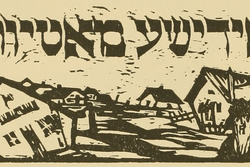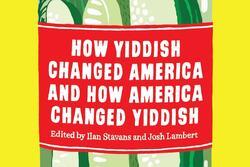What Does Duolingo Mean for Yiddish?
Last spring, I was finalizing the details for a planned research trip to Poland, expecting to spend my summer learning Yiddish at the Center for Yiddish Culture in Warsaw in between visiting the Warsaw Ghetto Archives to shore up my graduate research on Jewish partisans. Of course, by mid-March 2020, the trip was off the table; I spent a frantic few weeks trying to recoup my losses and secure a place in YIVO’s summer Yiddish immersion program online. But, I had to cut my time with YIVO short thanks to an unexpected pandemic-related crisis. My Yiddish education, I feared, was starting to look like a series of false starts. Spoiler: Duolingo might just have saved it.
Yiddish has always felt like a language within my grasp, by virtue of having an everyday speech style littered with words like oy and schmooze. And a substantive part of my graduate thesis centers around understanding Yiddish as a full language that’s been used to say all sorts of things—not just as a vocal exercise in nostalgia or as the tongue of the past. Taking a formal Yiddish class seemed like a way to rectify my own internalized ideas and childhood assumptions about the language. Although last fall, I did successfully completed a basic Yiddish course for beginners, once again through YIVO, when it was over, I found myself wanting more daily practice—while wholly lacking the motivation to create my own little Yiddishland. If I lived in New York, I reasoned, this would be easier—at least in Brooklyn I’d have a shot at overhearing a natural, live conversation in Yiddish. Enter Duolingo.
I’d dallied with Duolingo in the past—the free app gamifies language instruction in an attempt to build a daily habit out of learning, and succeeds in sucking you in. The pros and cons of Duolingo have been written about ad nauseum; you can’t actually become fluent from fifteen minutes a day on the program. It’s too easy to forget you’re trying to learn skills for real interactions (save, I suppose, for the Klingon students). Since the app relies on repetition, you can lazily navigate through exercises, racking up your daily points based on short-term memorization of vocabulary and word order.
But the spring release of the Yiddish course still feels like a big deal—on the day it launched, Twitter exploded with excitement for what some dubbed “Animal Crossing for Ashkenazim.” Efficacy aside, it’s exciting that there is now a way to engage with Yiddish on a platform used by millions of people. I downloaded the course the day it launched and blew past my bedtime getting hits of dopamine by correctly matching sounds to letters.
I’m still faithfully logging into Duolingo each day (at the moment I’m writing this, I’ve got a 61-day streak), and I have acquired a small arsenal of less-than-useful beginner phrases (including “the giraffe is in the pyramid”). Will this make me fluent? Not by a mile. But I solidified my ability to read and use the alef-beys—the Yiddish alphabet—within a week on the app, and I’ve greatly benefitted from Duolingo’s famously persistent push alerts. I’m engaging with Yiddish daily, which feels like an accomplishment in and of itself. As I come to the end of my master’s thesis research, I’m figuring out exactly how to learn a language on my own, and how to make it a project I engage with long term. Duolingo is no replacement for practicing with native, fluent speakers, but I feel a drive with the app that was missing when I was worried about numerical grades.
Language learning is unavoidably political—too many languages have been forcibly erased, denigrated as lacking “use” and mocked and belittled. English is often referred to as a “bully” language, sweeping across the globe via colonial expansion (it is of course not alone in this category—French, Spanish, Dutch, and Portuguese traversed the globe quite similarly). Even in Israel, Yiddish was overlooked in favor of revitalizing Hebrew, and the Holocaust killed nearly 90 percent of native Yiddish speakers alive at the time. Duolingo can’t single-handedly “save” Yiddish (if it needs to be saved at all—it is vital to remember that a few million people still use the language daily, primarily Hasidim in the New York area). But fortunately, it is not a lone beacon. Interest in Yiddish courses has skyrocketed in the last year, via YIVO, at colleges and universities that offer Yiddish, and through the Worker’s Circles in New York and Boston. I don’t want to inflate the importance of clicking cheerily animated characters encouraging me to write “Mom has wine” a couple dozen times, but there are now hundreds, if not thousands of users reading a bissel yidish every day. That certainly seems like something to celebrate.
I am hopeful that Duolingo will continue to build courses for languages in desperate need of preservation—like Native languages and Ladino. Access to another language gives you access to different ways of looking at the world. Scots Gaelic, another course I’ve dabbled in (to honor my Scottish grandmother), has a section dedicated to discussing the rain. An equivalent “specialty” section in Yiddish? Complaining.







